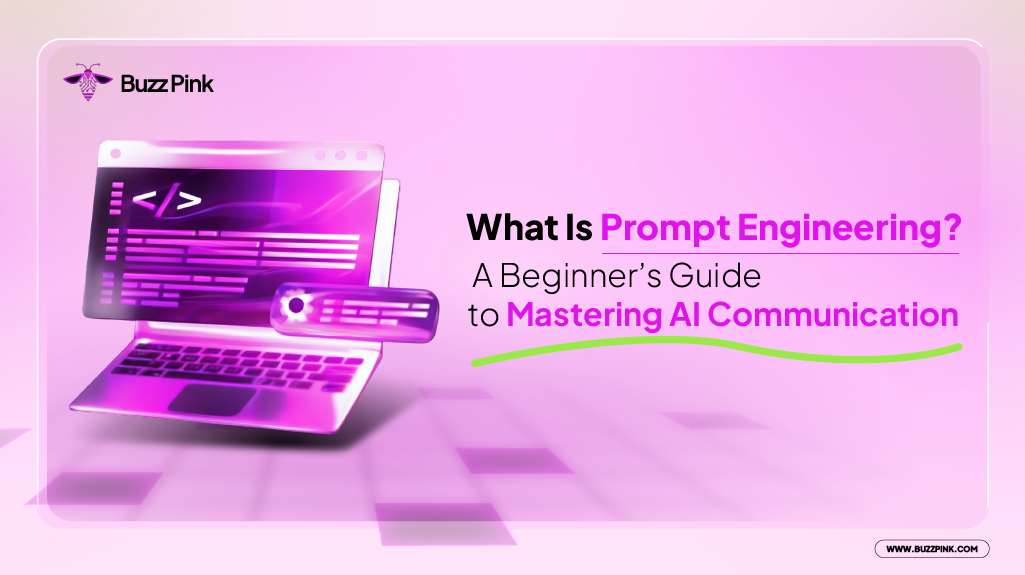Using generative AI has become a part of our daily lives, either to list down groceries, calculate calories, suggest a weekend agenda, or even more complex tasks, like summarizing a paper, helping with homework, and handling email responses for a job application.
Truth be told, generative AI can do so much more than these tasks, but only if it’s prompted properly. Some companies have started hiring prompt engineers to get the job done. So, what is prompt engineering? We will talk about the essentials and how to complete the prompt correctly.
What Is the Definition of Generative AI?
 Generative AI (or gen AI) is a type of artificial intelligence with the ability to fabricate new content in formats such as text, images, videos, and more. This technology is typically created using “foundation models,” which are large systems of artificial neural networks inspired by the human brain. So, if you’re familiar with deep learning, this foundation model is a more advanced version.
Generative AI (or gen AI) is a type of artificial intelligence with the ability to fabricate new content in formats such as text, images, videos, and more. This technology is typically created using “foundation models,” which are large systems of artificial neural networks inspired by the human brain. So, if you’re familiar with deep learning, this foundation model is a more advanced version.
This neural network’s multiple layers enable it to learn from large amounts of unstructured data, such as articles, images, or audio recordings with no clear pattern. Thanks to its extensive learning features, this model can perform a variety of functions, specifically answering questions, creating summaries, editing text, and even creating new content from scratch.
This generative AI technology represents a significant improvement over traditional AI. Previously, AI could only classify or recognize patterns based on limited data, but it can now create new things based on its learning outcomes.
Read More: Is SEO Still Relevant in 2025? Here’s Why the Answer Is Yes
For example, you could ask ChatGPT to write an essay about crypto history or use DALL-E to create a feminine Bored Ape drawing to be sold as an NFT. All of this is made possible by the foundation model’s ability to absorb, comprehend, and combine information from multiple sources in the same way that humans do.
What Is Prompt Engineering? A Brief Understanding
Following the explanation of Gen AI, prompt engineering is a technique for assigning specific instructions or questions so that Gen AI can respond appropriately. You can communicate in natural language as if you were chatting with a friend but with a clear structure and purpose.
For example, if you’re writing an email to a company, you could say, “Please create a professional email in response to a marketing analyst position I applied for.” If the result is too formal and isn’t exactly what you hoped for, you can just give further instructions: “Change the tone to semi-formal and warm, and emphasize that I’m interested in the offered position.”
Prompt engineering is also important for AI engineers because it allows AI to produce consistent, safe, and misunderstanding-free results. This is also useful for preventing attacks like prompt injection, which occurs when someone attempts to hijack AI logic with deceptive instructions. Prompt engineering is essentially the art of communicating with AI in order for it to become a truly helpful coworker.
Why Is Writing A Specific Prompt Important?
 When we interact with generative AI, the quality of the results is heavily influenced by how clear and specific the instructions or questions (known as prompts) are. When you give general and vague instructions, the results can be ambiguous. However, if you provide clear and detailed instructions, AI will provide more relevant and precise answers.
When we interact with generative AI, the quality of the results is heavily influenced by how clear and specific the instructions or questions (known as prompts) are. When you give general and vague instructions, the results can be ambiguous. However, if you provide clear and detailed instructions, AI will provide more relevant and precise answers.
Assume you ask AI to summarize a report on the latest trend on the internet. When you simply say, “Summarize the latest internet trend,” AI may provide a general summary. However, if you ask, “Summarize the latest internet trend on TikTok for the past 2 weeks,” the results can be far more useful. AI will direct its efforts towards finding the information and solutions you requested. This demonstrates that specific prompts can guide AI to produce output that meets our expectations.
Techniques to Hone Prompt Engineering Skill
To get the best results from generative AI, we need to learn a technique known as prompt engineering. Learning prompt engineering can begin by experimenting with different ways of formulating questions and determining which one produces the most satisfying results. Essentially, there are five strategies for honing your prompt engineering skills so that you can fully utilize the potential of generative AI in everyday situations.
-
Role-Playing Technique
Role-playing is a technique in which you instruct the AI to act as a specific person, such as an expert in a particular field, a celebrity, or a fictional character. This tactic involves the use of the AI’s advanced knowledge to reflect the style, perspective, and qualifications of the character you select.
For example, if you ask the AI to respond as if it were a PhD, the answers will be more technical and formal in tone. However, if you ask it to respond as if it were a poet, the responses will be more dramatic and imaginative.
Example prompt: “You are an economic analyst who is constantly monitoring the state of the international economy. Based on that role, help me prepare points to discuss in a meeting with the financial planning team about the potential for stocks and cryptocurrency in the next year.”
This way, the AI will adjust its responses based on the “role” you give it, making the results much more relevant and focused.
|
Role-Playing Formula |
| Imagine you are a [insert a role] who is [what the role usually does]. According to that role, help me [detailed instructions you want them to do] + [about the specific topics] + [time information, optional]. |
-
Style Unbundling Technique
Style unbundling is a technique in which AI is asked to analyze a person’s communication style or expertise and then break it down into structured elements. Not just copying, but thoroughly analyzing the style’s characteristics. This technique is useful for drawing inspiration from someone else’s style without completely plagiarizing it.
For example, you are impressed by how a political figure delivers a speech that elicits a lot of cheers and applause. You can ask, “Please identify the key elements of this political figure’s speech style.” Later, you can use the answer to write your own version of the speech.
Key elements that are highlighted include facial expressions, body gestures, loud or gentle tones of voice, the choice of the words used, the topic of discussion, and the fear-mongering or positive call-to-action persuasion style.
After that, you can give instructions: “Write a 5-minute speech text for the Engineering Club Chairman candidate’s campus campaign, using the key elements of the figure.” As a result, you’ll get a clear, interesting, and professional response without having to copy it directly.
|
Style Unbundling Formula |
| Identify [figure/brand] elements of their [specify which aspects of them you want the AI to analyze].
According to that, write a [specific time/word limit, optional] + [insert the format] for the [insert the detailed agenda] using the key elements of the [figure/brand]. |
-
Emotion-Prompting Technique
Emotion prompting is a technique that adds emotional context or urgency to our requests. When you demonstrate that the task is personally or professionally important, the AI will be more thorough and sympathetic in its response.
Example prompt: “Assist me in preparing a presentation point on a long-term beauty trend that will be discussed at an important meeting with my supervisor and manager. Make sure you highlight the importance of why we should keep this beauty product rather than discontinue it. It’s critical for my career.”
This technique allows the AI to adjust its communication style to be more convincing and emotionally impactful, which is especially useful when preparing a document or presentation involving your future.
|
Emotion-Prompting Formula |
| Help me prepare [insert the task required] about [specific topics] for [detailed agenda/event] with [important figure/brand, optional]. Make sure to emphasize [insert the urgency]. It is crucial for [personal reason]. |
-
Few-Shot Learning Technique
Few-shot learning is a technique that involves giving the AI a few examples before asking it to complete a similar task. This is particularly useful if you want the AI to follow a specific format or style.
Example prompt: “Here’s an example of a poem by novelist Charles Dickens. Now, write me a poem on a similar subject and style.”
By providing examples, the AI will better understand the context and style you desire, resulting in more accurate results and meeting expectations.
|
Few-Shot Learning Formula |
| Here’s an example of [insert the context] + [paste the example]. Now, write [the desired context] according to the example I provided. |
-
Synthetic Bootstrap Technique
Synthetic bootstrapping is a technique in which you ask the AI to generate a large number of examples based on a given input. These examples can serve as preparation for the next prompt or as test material.
This technique is extremely useful if you do not yet have a large amount of real data. For example, suppose you need feedback from a large number of people but don’t have enough connections or time to collect it.
You can ask the generative AI, “Generate 8 examples of user personas for those taking the HSK 1 Mandarin class. Input their name and age, occupation, whether they want a private or public class, the number of class hours they want, and their learning objectives.”
Following that, continue to specify what you hope to get from the generated personas: “Generate student feedback on HSK 1 learning materials based on these personas.” This allows you to simulate real-world scenarios without the need for extensive research.
|
Synthetic Bootstrap Formula |
| Generate [exact amount] + [context you need] that involves [lists of specifications].
Generate feedback on [materials that need to be evaluated] based on [context you need]. |
Impact of Learning Prompt Engineering in the Workplace
According to McKinsey research, generative AI has the potential to significantly improve performance in a variety of fields, including marketing, customer service, and software development. It has the potential to boost global economic value by up to USD 4.4 trillion per year. However, this implies that AI can automate a large number of jobs.
Generative AI can replace work activities that currently consume 70% of an employee’s time, particularly in knowledge-based jobs that require advanced education. So, while AI can assist us in our work, it has the potential to change the way we work and even the types of jobs that exist.
Read More: 7 Best Website Maintenance Services in Singapore Every Business Should Know
McKinsey predicts that between 2030 and 2060, half of today’s jobs will be automated. This means that significant changes will take place over the next 5-10 years.
The Change in the Working Field and Reskilling Adjustment
 Workers will need to learn new skills as the number of jobs affected grows. Not only technical skills like coding but also how to apply AI in their daily work. Organizations and institutions will also need to play an important role in assisting their employees to relearn or even transition into new positions.
Workers will need to learn new skills as the number of jobs affected grows. Not only technical skills like coding but also how to apply AI in their daily work. Organizations and institutions will also need to play an important role in assisting their employees to relearn or even transition into new positions.
McKinsey predicts that while new jobs, such as prompt engineers, will be created, the number of workers who will be laid off will be less than expected. In fact, 4 out of 10 AI-powered organizations plan to retrain more than 20% of their workforce rather than replace it. As a result, career opportunities remain available as long as we are prepared and willing to adapt.
The Future of Prompt Engineering
As artificial intelligence evolves, so will prompt engineering. In the future, we will be able to create prompts that include text, images, and even code all at once. Experts are also developing adaptive prompts, which are instructions that automatically adapt to context.
Furthermore, ethical considerations for the use of generative AI are emerging, such as ensuring that AI results are unbiased and accountable. However, as long as ethical regulations are not officially established, generative AI users are expected to use this tool responsibly.
Prompt Engineer Career and Opportunity
Jobs as prompt engineers are becoming increasingly sought after. There are many open positions on job vacancy websites, with salaries ranging from hundreds of millions per month. To become a prompt engineer, you typically need a background in computer science or technical fields like Python programming, natural language processing (NLP), and knowledge of AI models.
However, it is not limited to that, as there are those who are self-taught and have a background in writing or communication. The most important thing is to keep learning, experimenting, and understanding how AI works. Given that, no matter how efficient AI proves to be, it will always require humans who fully comprehend how to communicate with it.
Conclusion
Generative AI is now part of everyday life, from writing emails to summarizing reports. However, to achieve the best results, clear, specific prompts are required, which is where prompt engineering comes in. It is the key to making AI truly useful, turning it into a smart assistant rather than a simple tool.
As artificial intelligence transforms the workplace, prompt engineering is becoming a must-have skill. Prompt engineering is the practice of crafting clear, specific instructions to guide AI towards better results. It boosts productivity and helps you stay relevant in a world where automation is growing fast. With the right prompts, you’re not just using AI, you’re steering it.
Kamila Putri is a content strategist and digital marketing expert who helps brands craft messages that resonate and drive results. With a strong foundation in SEO, brand voice, and data-driven strategy, she has produced content that performs, whether it's optimized web copy, lead-generating campaigns, or conversion-focused messaging. At Buzz Pink, she applies this expertise to help clients grow through smart, search-focused digital strategies that engage, inform, and convert.


